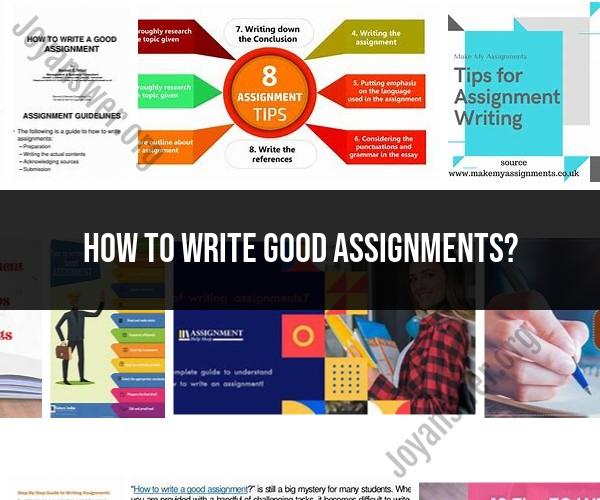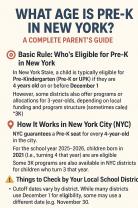How to write good assignments?
Writing good assignments is essential for academic success. Here are some key principles and guidelines to help you create effective assignments:
Understand the Assignment:
- Read the assignment instructions carefully. Make sure you understand the requirements, objectives, and expectations of the assignment.
- If you have any doubts or questions, seek clarification from your instructor.
Start Early:
- Don't procrastinate. Begin working on your assignment as soon as it's assigned to allow time for research, planning, and revisions.
Research:
- Gather relevant information from credible sources. Use libraries, academic databases, and scholarly articles to support your arguments.
Organize Your Thoughts:
- Create an outline to structure your assignment. Outline key points, arguments, and supporting evidence.
Clear Thesis Statement:
- Ensure your assignment has a clear and concise thesis statement. It should state your main argument or purpose.
Proper Formatting:
- Follow any formatting guidelines provided by your instructor, such as font, margins, spacing, and citation style (APA, MLA, Chicago, etc.).
Introduction:
- Write a compelling introduction that provides context and background for your assignment. It should clearly state your thesis.
Body Paragraphs:
- Each paragraph should focus on a single idea or point.
- Use topic sentences to introduce the main idea of each paragraph.
- Provide evidence and examples to support your arguments.
- Use transitional phrases to connect paragraphs and ensure a logical flow.
Conclusion:
- Summarize the key points of your assignment.
- Restate your thesis and emphasize your main arguments.
- Avoid introducing new ideas in the conclusion.
Clarity and Conciseness:
- Use clear and concise language. Avoid unnecessary jargon and complex sentence structures.
- Ensure your writing is easily understandable by your target audience.
Proofreading and Editing:
- Proofread your assignment for grammar, spelling, and punctuation errors.
- Edit for clarity, coherence, and consistency.
- Consider seeking feedback from peers or using online tools for editing assistance.
Citations and References:
- Properly cite all sources used in your assignment to avoid plagiarism.
- Create a bibliography or reference page with complete source information.
Originality:
- Avoid plagiarism by citing sources and providing your own insights and analysis.
- Use plagiarism detection tools if available to check your work.
Adherence to Instructions:
- Ensure your assignment complies with all the instructions and requirements provided by your instructor.
Review and Revision:
- Review your assignment multiple times before submission.
- Ask someone else to review it for additional feedback.
- Make necessary revisions to improve clarity and coherence.
Proof of Effort:
- Make your best effort to showcase your understanding and critical thinking skills.
- Go beyond summarizing and demonstrate your ability to analyze, synthesize, and evaluate information.
Remember that writing good assignments is a skill that can be developed and improved over time. Paying attention to these principles and guidelines will help you produce well-structured and effective assignments.
How to write high-quality assignments?
To write high-quality assignments, you should follow these steps:
- Understand the assignment. Make sure you know what the assignment is asking you to do. Read the instructions carefully and ask your instructor for clarification if needed.
- Research and gather information. Once you understand the assignment, you need to gather the information you need to complete it. This may involve reading books, articles, and other online resources. You may also need to interview experts or conduct experiments.
- Organize your thoughts. Once you have gathered your information, you need to organize your thoughts and develop a thesis or main argument for your assignment. This will help you to write a clear and focused paper.
- Write a draft. Don't try to write a perfect assignment on the first draft. Just get your ideas down on paper (or on the computer). You can always go back and edit later.
- Revise and edit. Once you have a draft, take some time to revise and edit it. Make sure your writing is clear, concise, and grammatically correct. You should also check your citations for accuracy.
What are the essential components of a good assignment?
The essential components of a good assignment are:
- A clear and concise thesis statement. The thesis statement is the main argument or point of your assignment. It should be stated clearly and concisely in the introduction of your paper.
- Supporting evidence. All of the claims that you make in your assignment should be supported by evidence. This evidence can come from your research, from your own experiences, or from expert opinions.
- Proper formatting and citation. Your assignment should be formatted according to the style guide specified by your instructor. You should also cite all of your sources properly.
- Clear and concise writing. Your writing should be clear, concise, and easy to read. You should avoid using jargon and overly complicated sentences.
How to conduct research and gather information for your assignment?
To conduct research and gather information for your assignment, you can use a variety of sources, including:
- Books and articles. You can find books and articles at your library or online.
- Websites. There are many websites that provide information on a variety of topics.
- Databases. Databases are searchable collections of information on a variety of topics.
- Interviews. You can interview experts on the topic of your assignment.
- Experiments. If your assignment is on a scientific topic, you may need to conduct experiments.
When you are gathering information, it is important to be critical of your sources. Make sure that the information you are using is credible and accurate.
What is the importance of proper formatting and citation in assignments?
Proper formatting and citation are important in assignments because they show that you have done your research and that you are familiar with the academic conventions of your field. Proper formatting also makes your paper easier to read for your instructor.
The most common formatting styles used in academia are MLA, APA, and Chicago style. Your instructor will tell you which style guide to use for your assignment.
How to proofread and edit your assignments for clarity and accuracy?
Once you have finished writing your assignment, it is important to proofread and edit it carefully. This will help you to catch any errors in grammar, spelling, or punctuation. You should also check your citations for accuracy.
Here are some tips for proofreading and editing your assignments:
- Read your assignment aloud. This can help you to catch errors that you might miss when reading silently.
- Ask a friend or family member to proofread your assignment for you.
- Use a grammar checker. However, keep in mind that grammar checkers are not perfect, so it is important to proofread your work carefully even after using a grammar checker.
By following these tips, you can write high-quality assignments that will impress your instructors.












